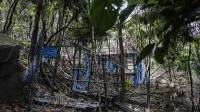Malaysia should immediately release the final report and recommendations of the Royal Commission of Inquiry (RCI) into the human trafficking and mass graves of Rohingya and Bangladeshis discovered in Wang Kelian, Perlis State in 2015, said Fortify Rights on Wednesday.
The RCI submitted its report to the King of Malaysia a year ago this month, according to media reports.
Fortify Rights released a short film today with footage of Wang Kelian, where Malaysian authorities discovered 139 graves and 28 suspected human trafficking camps.
“Malaysian citizens and survivors of trafficking deserve access to the final report,” said Matthew Smith, Chief Executive Officer at Fortify Rights. “This is a matter of truth, justice, and accountability.”
Between 2012 and 2015, transnational criminal syndicates trafficked at least 170,000 mostly Rohingya from Myanmar and Bangladesh to Malaysia, generating an estimated US$50 million to $100 million annually.
On February 28 last year, Malaysian announced the creation of a RCI to investigate and ensure accountability for the human trafficking and mass graves discovered in Wang Kelian.
The government gave the commission six months to submit its final report and recommendations.
Former Chief Justice Tun Arifin Zakaria led the seven-member RCI, which included former Inspector-General of Police Tan Sri Norian Mai and other former government and elected officials.
The RCI called 48 witnesses, including police and Rohingya survivors, during 17 days of hearings in Kuala Lumpur.
More than three months after it submitted its final report, in January 2020, former Malaysian Home Minister and current Prime Minister Tan Sri Muhyiddin Yassin announced, "The ministry will present the report to the Cabinet next week and if the Cabinet agrees, we will allow the report to be made public.”
There has been no further information about the report following this announcement.
In March last year, the Human Rights Commission of Malaysia (SUHAKAM) and Fortify Rights published a 121-page report, “Sold Like Fish”: Crimes Against Humanity, Mass Graves, and Human Trafficking from Myanmar and Bangladesh to Malaysia from 2012 to 2015.
It was based on a multi-year investigation into human trafficking of mostly Rohingya from Myanmar and Bangladesh to Malaysia.
Eyewitness testimonies in the report indicate complicity and direct involvement of state authorities in the transnational trade of Rohingya refugees.
“The RCI was mandated to help bring perpetrators to justice, and that hasn’t happened,” said Smith. “The government must act. There have been no changes in policy and not even a formal public reckoning of the crimes committed.”
Following a similar discovery of mass graves in Thailand in 2015, in 2017 Thai courts convicted 62 defendants, including nine Thai government officials, for crimes related to the trafficking of Rohingya and Bangladeshis to Malaysia via Thailand.
Since 2015, Malaysian courts have only convicted four people of trafficking-related offenses in relation to the mass graves discovered at Wang Kelian.
None of the convicted traffickers are Malaysian nationals.
The US currently ranks Malaysia a “Tier-2 Watchlist” country, its second lowest ranking, in the Department of State’s annual Trafficking in Persons (TIP) report.
The 2020 TIP report says: “Despite allegations of official complicity in migrant smuggling and trafficking crimes in relation to the 2015 discovery of migrant camps and mass graves in Wang Kelian, containing bodies of suspected Rohingya and Bangladeshi victims of extortion, torture, and other crimes, authorities have not brought charges against any Malaysian official or private citizen.”
The TIP report notes that the RCI report has not been made public. The Government of Malaysia has an obligation to act on the RCI’s report.
When fundamental rights are violated, international law provides for the right to “an effective remedy” as determined by a competent authority.
As part of this remedy, Principle 22 of the Basic Principles and Guidelines on the Right to Remedy, adopted by the UN General Assembly, holds that states should provide survivors and relatives of victims of violations with “verification of the facts and full and public disclosure of the truth.”
The UN Special Rapporteur on the Promotion of Truth, Justice, Reparation and Guarantees of Non-Recurrence noted that this obligation, known as the right to truth, includes the right of survivors, the relatives of victims, and the public “to seek and obtain all relevant information concerning the commission of the alleged violation, the fate and whereabouts of the victim and, where appropriate, the process by which the alleged violation was officially authorised.”
The Malaysian government should fulfill the right to truth of the Wang Kelian survivors, victims, and their relatives under international law and provide them and the general public with the RCI’s full report so they can assess it for themselves, said Fortify Rights.
Rohingya are being left to die at sea. Does anyone care?
September 17, 2020Deepmala Mahla and Hassan Noor
Last week some 300 Rohingya men, women, and children washed up on the shores of Indonesia's Aceh province.
Starving and desperate, they had spent the past seven months on the open waters of the Andaman Sea, looking in vain for a safe harbor. The survivors said at least 30 people had died on the perilous journey.
For Rohingya, this is sadly nothing new, but rather a nightmarish history that keeps repeating. This year, hundreds have been left stranded on overcrowded and squalid boats across Asia. The governments of the 10-member Association of Southeast Asian Nations have turned their backs on them, closed their borders, ignored their plight, and refused to let boats disembark, leading to scores of deaths. Tellingly, the boat that landed in Aceh last week was rescued by Indonesian fishermen, not the Indonesian authorities.
Back in 2015, when hundreds of Rohingya people lost their lives at sea in what is now infamously known as the Asian boat crisis, ASEAN vowed to never again abandon them to the sea. Sadly, recent events have exposed the hollowness of those commitments. Ahead of another sailing season when refugees will once again take their chance on the high seas, South and Southeast Asia's leaders must make a collective decision to choose lives over politics.
Since January at least 2000 refugees have been stranded on boats in the Andaman Sea and the Bay of Bengal. The vast majority are Rohingya who, with the help of human traffickers, have fled the uncertain future and day-to-day drudgery of the refugee camps in Bangladesh.
With many Rohingya still traumatized by the brutal violence carried out by the Myanmar military in 2017, forcing 700,000 across the border into Bangladesh, many now relate horrific experiences at sea. Famished, beaten, many are simply killed by traffickers -- their supposed saviors. At least 140 people are thought to have died since January.
On one boat that washed up in Bangladesh in April, authorities found more than 150 unaccompanied children among the severely malnourished survivors. One 16-year-old Rohingya girl told us: "We were at sea for almost two months. I saw a man dying and the trafficker threw him overboard. The trafficker beat us when we asked him to turn around and go back to Bangladesh. I never thought I would survive."
But while Rohingya suffer, countries like Indonesia, Malaysia, and Thailand across the region have often ignored their struggle, with some countries even pushing the boats back to sea. This is not only inhumane but a blatant violation of international law. Those that do make it to land face uncertain futures.
All too similar to the 2015 tragedy, it is appalling that governments have failed to live up to the commitments they made then to avoid the same thing happening again.
Despite initiating the so-called Bali Process in 2016 -- a regional anti-trafficking forum to facilitate policy and information sharing on people smuggling and other transnational crimes -- the regional response remains as paralyzed as five years ago. Member states have mostly failed to trigger the so-called Consultative Mechanism, which could have helped save lives through search-and-rescue missions and the provision of essential aid.
ASEAN has been similarly hamstrung, failing to launch the search-and-rescue operations it committed to in 2012. Nor have any meaningful steps been taken to share responsibility for refugees. In fact, at the July ASEAN summit in Hanoi, at the height of this year's crisis, maritime refugees did not even rate a mention in the post-summit statement.
There is no doubt that refugees will board boats again when the current monsoon season ends. Now is time for leaders of South and Southeast Asia to put politics aside and protect the lives of desperate people. Governments should end the practice of pushing refugees back to sea, and instead provide aid to those who disembark.
ASEAN must also take a collective approach to the maritime refugee operations that focus on search-and-rescue and share responsibility across borders. The Bali Process countries -- in particular its co-chairs, Australia and Indonesia -- should take urgent action to ensure that they make use of the frameworks that were established in 2016 to protect refugees.
Ultimately, however, this is a crisis that can only be solved by addressing the root causes of the Rohingya migration crisis. Brutally repressed for decades, Rohingya are still denied their right to citizenship and documentation in Myanmar. Harsh restrictions on their movements have confined them to what rights groups have described as "an open-air prison" in Rakhine State. No one has been held accountable for the atrocities committed against them in 2017.
As long as these conditions persist, Rohingya will continue to risk their lives to escape whether from Myanmar or from the refugee camps in Bangladesh. Myanmar must act to improve the lives of Rohingya, uphold their rights and well-being, and create the conditions that make the safe return of refugees possible.
With the next sailing season approaching, regional governments have an opportunity to show that they have learned the lessons of the past. Lives are at stake.
Priest compared BLM to 9/11 attackers
September 17, 2020DEARBORN, Mich. (AP) — The pastor of a Roman Catholic church in suburban Detroit is apologizing after a fellow priest likened Black Lives Matter to the people responsible for the 9/11 attacks.
The Rev. Paul Graney's homily Saturday created "division, anger, confusion and chaos,” the Rev. Bob McCabe of the Church of the Divine Child in Dearborn said on Facebook.
“As your pastor, I want to assure you that at Divine Child we love and respect all persons. Every person is sacred in the eyes of God regardless of their race, religion or sexuality," McCabe said.
Graney used his homily to rail against BLM, which is a global movement whose goal is to eradicate systemic racism and white supremacy and to oppose violence against Blacks.
Graney said it’s "very good” that BLM’s website says it works for justice for Blacks, but that's where his praise ended.
“Al-Qaeda’s goal was to come to the United States and kill Americans. Really just wanted to wipe America off the map. And they would have done it if they could,” said Graney, who has been a priest since 2016.
“But today, those who we see wanting to bring down America are Americans, and they want to do it under the facade of justice, freedom and love," the priest said. "But it is all a big bunch of baloney. It’s anti-Christian. It’s anti-family. It’s evil.”
McCabe said Graney didn't preach about the theme of the day's Gospel, which centered on forgiveness.
Oxford University Museum removes shrunken heads which 'reinforced racist thinking'
September 17, 2020A collection of shrunken heads has been removed from a museum linked to Oxford University as part of what it refers to as its decolonization process.
The Pitt Rivers Museum has been closed for several months due to the coronavirus pandemic. When it reopens on September 22, it will look rather different to visitors.
Staff have been removing human remains from its collection of more than 500,000 artifacts, following a three-year review of displays and programming "from an ethical perspective." Overall, 120 objects containing human remains were removed from being on view, plus an additional 71 non-biological objects which were in the same displays, the museum told CNN Tuesday.
The museum said in a statement Monday that the changes were motivated by a desire to "deeply engage with its colonial legacy."
The museum of anthropology, ethnography and archeology acquired its vast collection, which includes musical instruments, weapons, masks, textiles, jewelery and, tools, over 130 years.
Among the artifacts are the Shuar Tsanta -- or shrunken heads -- made by the Shuar and Achuar people of Ecuador and South America.
Formed from human, sloth and monkey heads, they were much sought after and collectors would pay one gun per head, "leading to a steep increase in violent warfare locally at the height of the 19th and 20th century collecting," the museum said.
Acquired by the museum between 1884 and 1936, the heads have been on display since the 1940s.
The museum inspired the magic shop in Knockturn Alley in the film adaptation of "Harry Potter and the Prisoner of Azkaban," which featured talking shrunken heads. A spokeswoman for the museum told CNN that the production team visited the museum while researching the scene.
Much of the museum's collection is "closely tied to British imperial expansion and the colonial mandate to collect and classify objects from the world over," the museum said, with many of the historic labels on the artifacts featuring "racist and derogatory language, commonly used at the time."
The heads, as well as other human remains including Naga trophy heads and the mummy of an Egyptian child, have now been moved to storage.
The museum said that it has not been asked to return the heads to the Shuar community, but that it remains "open to any discussions about their repatriation and will continue in conversation with Shuar delegates over the next years."
The museum said that it still "takes care of," rather than owns, more than 2,800 human remains from different parts of the world.
Descendant communities are being contacted to find "the most appropriate way to care for these complex items," it added.
Laura van Broekhoven, director of the museum, said in a statement: "Our audience research has shown that visitors often saw the museum's displays of human remains as a testament to other cultures being 'savage', 'primitive' or 'gruesome.'
"Rather than enabling our visitors to reach a deeper understanding of each other's ways of being, the displays reinforced racist and stereotypical thinking that goes against the museum's values today."
Marenka Thompson-Odlum, research associate at the museum who curated several of the new displays, said the removal of the items creates space to tell more "expansive stories."/CNN
Oil up more than 4% as U.S. stockpiles fall, hurricane hits output
September 17, 2020NEW YORK (Reuters) - Oil prices jumped more than 4% on Wednesday, following a drawdown in U.S. crude and gasoline inventories and as Hurricane Sally forced a swath of U.S. offshore production to shut.
Brent crude LCOc1 settled at $42.22 a barrel, up $1.69, or 4.2%. U.S. crude CLc1 finished $1.88, or 4.9%.at $40.16 a barrel.
U.S. crude stocks fell 4.4 million barrels last week to 496 million barrels, their lowest since April, the U.S. Energy Information Administration said, compared with analysts’ expectations in a Reuters poll for a 1.3 million-barrel rise, [EIA/S]
U.S. gasoline stocks fell 400,000 barrels, the EIA said, more than double the draw forecast, while refining utilization rates ticked up 4 percentage points.
“Today’s strong gains were largely attributable to bullish crude guidance out of the EIA release,” said Jim Ritterbusch of Ritterbusch and Associates.
“The bulk of the (crude) stock decline was driven by an unexpectedly large upswing in U.S. refinery activity led by the Gulf Coast,” he said.
Sally, which made landfall on the U.S. Gulf Coast as a Category 2 hurricane, also boosted oil prices as more than a quarter of offshore output shut due to the storm. [nL1N2GD0GO]
Roughly 500,000 barrels per day (bpd) of offshore crude oil production was taken offline in the U.S. Gulf of Mexico, according to the U.S. Interior Department, roughly a third of the shut-ins caused by Hurricane Laura, which landed farther west in August.
Oil collapsed to historic lows as the coronavirus crisis hit demand. A record supply cut by OPEC and its allies, a grouping known as OPEC+, and an easing of lockdowns have helped Brent recover from a 21-year low below $16 in April.
Prices have sunk in September, pressured by rising coronavirus cases and concerns about demand.
The Organization of the Petroleum Exporting Countries and International Energy Agency both cut their demand outlooks this week. [IEA/M][OPEC/M]
A panel of OPEC+ oil ministers meets to review the supply pact on Thursday and is unlikely to recommend further output curbs despite the price drop, sources told Reuters.
Oil gains as hurricane shuts U.S. output, stockpiles fall
September 16, 2020FILE PHOTO: Dust blows around a crude oil pump jack and flare burning excess gas at a drill pad in the Permian Basin in Loving County, Texas, U.S. November 25, 2019.REUTERS/Angus Mordant
TOKYO (Reuters) - Oil prices rose on Wednesday, extending gains from the previous session, as a hurricane disrupted U.S. offshore oil and gas production and an industry report showed a big drop in U.S. crude stockpiles.
Brent crude LCOc1 was trading up 15 cents, or 0.4%, at $40.68 a barrel by 0055 GMT, while U.S. crude CLc1 gained 18 cents, or 0.5%, to $38.46 a barrel. Both contracts rose by more than 2% on Tuesday.
More than 25% of U.S. offshore oil and gas output was shut and export ports were closed on Tuesday as Hurricane Sally sat just off the U.S. Gulf Coast.
“Our current estimate for the total outage associated with the Sally weather system is between 3 million and 6 million barrels of oil over approximately 11 days,” Rystad Energy said in a note.
That is likely to help reduce stockpiles although refineries were also shut down, cutting demand for oil.
U.S. crude oil inventories fell by 9.5 million barrels last week, although gasoline inventories increased, data from industry group the American Petroleum Institute showed on Tuesday. [API/S]
ADVERTISEMENT
Analysts had expected oil stocks to increase by 1.3 million barrels. Official data on U.S. stockpiles is due out later on Wednesday and often conflicts with the industry figures. [EIA/S]
Meanwhile, oil producers and traders are painting a bleak picture for a recovery in fuel demand globally as the COVID-19 pandemic rages on, hammering economies.
UN urges Myanmar to immediately extend cease-fire
September 16, 2020DHAKA, Bangladesh
The UN has expressed concern over human rights violations and armed clashes in Myanmar and is urging the Aung San Suu Kyi administration to immediately take steps to restore peace in the country.
“Myanmar continued to witness intensified armed clashes between the Tatmadaw [Myanmar army] and ethnic armed organizations, particularly in the states of Rakhine, Chin, Shan, Kachin and Kayin,” the Office of the United Nations
High Commissioner for Human Rights (OHCHR) said in a new report.
The report is set to be discussed at the 45th regular session of the UN Human Rights Council scheduled on Sept. 14 to Oct. 6 at the UN office in Geneva.
The report was prepared on the basis of primary and secondary information collected from various sources, including primary witness testimonies.
It expresses concerns over continuing civilian casualties due to armed clashes.
“The Tatmadaw did not heed the call of the Secretary-General of the United Nations for a global ceasefire and instead, on 26 June 2020, launched another clearance operation, in Rathedaung township, forcibly displacing thousands of civilians.”
The report also records in detail violations in other states in Myanmar.
“Since 2019, fighting between the Tatmadaw and the Arakan Army [armed Buddhist rebels] in Rakhine and Chin states has intensified in scale and ferocity, resulting in deaths and injuries and the destruction of civilian property and other civilian objects.”
Concerns over attacks on civilians
The report accused Myanmar’s army of launching crackdowns on civilians even in places where no presence of the Arakan Army was reported.
“It appears that the Arakan Army was not active or present in the areas where these attacks took place and no armed clashes were reported to have been ongoing at that time,” it added.
It records that on April 7, 2020, Myanmar fighter jets carried out an airstrike in Chin state, “killing seven civilians and wounding six women and one child.”
“Eight houses and a rice mill were destroyed and the villagers were forced to flee.”
During the first five months of 2020, at least 137 civilians, including 25 members of the Rohingya minority, were reportedly killed and 386 wounded, including 44 Rohingya, in the Rakhine and Chin states, according to the report.
“On 29 February 2020, a Tatmadaw convoy opened fire on a village in Mrauk-U township, killing six Rohingya and wounding another six,” the report said.
Citing eyewitnesses, it added that the Tatmadaw fired indiscriminately on the village for over an hour after a vehicle in their convoy was damaged by a mine explosion.
“Schools, religious sites and civilian homes have been targeted in attacks and damaged by heavy artillery or by Tatmadaw patrols,” the report said, adding that at least 17 schoolchildren were wounded when a mortar shell hit a primary school in Buthidaung township on Feb. 13, 2020.
The report also decried a brutal crackdowns on civilians in the townships of Kyauktaw, Minbya, Paletwa and Kyauk Seik.
“In some cases, the Tatmadaw have rounded up the entire male populations of villages, often blindfolding them, before transferring them to unknown locations,” it said.
Immediate cease-fire
The report emphasizes restoring peace and urges Myanmar’s government to “immediately extend the ceasefire throughout the whole country and end violations.”
As part of a conducive peace process, it also recommends doing “prompt, independent, impartial and thorough investigations into all allegations of violations” including “war crimes and crimes against humanity in Rakhine and Chin states” and ensuring that “perpetrators are brought to justice through transparent and credible processes.”
The report also asks the Suu Kyi administration to acknowledge that “sexual crimes” have occurred in Rakhine state and other parts of the country and to “take concrete measures to identify perpetrators and hold them accountable and ensure health-care and psychosocial services for survivors.”
On the one-sided upcoming general election in Myanmar set for this November, the report urges officials to ensure an environment for holding a fair and participatory election.
It points to the deprivation of minority Rohingya people in their home country and recommends amending the controversial 1928 Citizenship Law to remove “links between ethnicity and citizenship and restore the citizenship of the Rohingya.”
It also recommends ensuring an independent media and civil society and cooperating and engaging “meaningfully with the newly appointed [UN] Special Rapporteur on the situation of human rights in Myanmar and relevant international justice and accountability mechanisms.”
The report also urges ethnic armed groups in Myanmar to take “all measures to end hostilities and violations of international humanitarian law and abuses of international human rights law.”
Consequences, not recommendations
Separately, the Burma Human Rights Network (BHRN), a UK-based rights group, called on the international community Monday “to promote consequences for Burma’s failures rather than more recommendations.”
Referring to a recent joint statement by eight countries including the US and UK, the statement said, using an older name for Myanmar: “Burma has a long history of discussing how to improve its human rights and democratic issues with the international community and for just as long has managed to do the exact opposite of what is recommended.”
“The country is failing as a democracy, is subjecting its citizens to brutal military operations, is continuing to deny its past atrocities despite its own soldiers now speaking out about them and has no viable path for equitable repatriation for the Rohingya,” said BHRN Executive Director Kyaw Win.
Speaking to Anadolu Agency, he added: “Burma has a long history of buying time and not doing anything. Burma has completely disregarded the call of the UN secretary general to cease fighting during the COVID-19 pandemic.
Therefore, it is time for Burma to face consequences.”
The statement also urges sanctions on Myanmar.
“The use of targeted sanctions should be increased for the country’s failures.
“Companies with connections to the government or military should also be considered for new sanctions until Burma demonstrates a serious effort to address its horrendous human rights violations and prevents them from recurring,” it added.
Persecuted people
The Rohingya, described by the UN as the world's most persecuted people, have faced heightened fears of attack since dozens were killed in communal violence in 2012.
According to Amnesty International, more than 750,000 Rohingya refugees, mostly women and children, fled Myanmar and crossed into Bangladesh after Myanmar forces launched a crackdown on the minority Muslim community in August 2017, pushing their numbers in Bangladesh above 1.2 million.
Since Aug. 25, 2017, nearly 24,000 Rohingya Muslims have been killed by Myanmar's state forces, according to a report by the Ontario International Development Agency (OIDA).
More than 34,000 Rohingya were also thrown into fires, while over 114,000 others were beaten, said the agency report titled Forced Migration of Rohingya: The Untold Experience.
As many as 18,000 Rohingya women and girls were raped by Myanmar's army and police and over 115,000 Rohingya homes burned down while 113,000 others vandalized, it added./aa
Turkey successfully tests its 1st flying car
September 16, 2020ISTANBUL
Turkey’s first indigenous flying car, called Cezeri, was successfully tested in Istanbul, its manufacturer said on Tuesday.
Designed and manufactured by Turkish engineers, Cezeri ascended to 10 meters (32.8 feet) in its 230 kilograms (507 pounds) prototype flight tests, manufacturer Baykar said in a statement.
“We will make more advanced prototypes in the upcoming process, and perform flights with a human [on board],” Selcuk Bayraktar, the chief technology officer, was quoted as saying.
Bayraktar added that it would take an estimated 10-15 years for Cezeri to hit the roads and 3-4 years to use for recreational purposes such as quad bikes in rural areas.
“After smart cars, the revolution in automotive technology will be in flying cars. So from this point of view, we are preparing for tomorrow's races, rather than today's,” he added.
Last September, Cezeri was displayed at Teknofest, the Turkish technology and aerospace fair, in the metropolitan city of Istanbul.
The car is named after Ismail al-Jazari, a renowned 12th-century Muslim engineer and polymath.
Baykar, established in 1984, produces armed and non-armed drones, control systems, simulators, and avionics systems./aa
US: Hackers working for China have successfully compromised US government systems: A federal cybersecurity agency
September 16, 2020• Hackers linked to the Chinese government have successfully infiltrated US government systems across "many sectors," according to the Cybersecurity and Infrastructure Security Agency and the FBI.
• The hackers are taking advantage of publicly available code and exploits that have already been publicized in order to hack into US entities.
• The report suggests that, after vulnerabilities are discovered and publicized by US defenders, hackers are often able to exploit the vulnerabilities before government agencies patch them.
• CISA did not specify which agencies were compromised or how many records were potentially stolen, but says that hackers were frequently successful using "low-complexity" methods.
Hackers linked to the Chinese government have repeatedly attempted to compromise US government systems over the past year — and in some cases, they were successful, according to the Cybersecurity and Infrastructure Security Agency, the Department of Homeland Security's cybersecurity division.
In an advisory published with the FBI this week, CISA warned that Chinese hackers appeared to be using publicly available information about vulnerabilities that security researchers had discovered — but that hadn't yet been patched — in order to target US entities.
"CISA has observed the threat actors using a variety of open-source and publicly available exploits and exploit code to compromise Federal Government networks," the agencies said in the advisory.
US intelligence agencies have warned of attacks originating from China's state-run hacking teams for years, and there's nothing particularly new about the practice. But the advisory published this week shows that mere awareness of attempted hacks isn't enough to hold them off when government agencies don't adequately protect their systems.
The advisory doesn't say which agencies were targeted, nor does it disclose the number of records that were potentially stolen. But it outlines how hackers have successfully targeted the US in the past year using "low-complexity" tactics.
Those tactics included sending malicious links in phishing emails to US officials, buying domain names to pose as trustworthy organizations, and buying passwords leaked in other breaches to try and compromise officials' accounts.
Hackers also regularly exploited vulnerabilities that security researchers had previously identified and publicized. One of the resources that hackers are using is a database of known vulnerabilities compiled by the National Institute of Standards and Technology.
"CISA analysts have observed a correlation between the public release of a vulnerability and targeted scanning of systems identified as being vulnerable," the advisory reads.
The findings suggest that US agencies need to work more quickly to patch vulnerabilities that have been publicly documented. In one case, hackers used an exploit to target US systems weeks after the exploit was publicly disclosed.
"CISA and the FBI recommend that organizations place an increased priority on patching the vulnerabilities routinely exploited," the advisory reads. "CISA and the FBI also recommend that organizations routinely audit their configuration and patch management programs to ensure they can track and mitigate emerging threats."
Business Insider
Mass grave of victims ‘killed in violent exorcism’ linked to religious cult in Panama
September 16, 2020Authorities in Panama have discovered a mass grave they believe contains the bodies of people tortured and killed by a religious cult.
Investigators had to hike through the mountains for 10 hours to reach the grave in a remote indigenous province in the country’s north-west.
Skeletal remains are being removed from the grave where they will later be forensically examined.
The discovery comes after another grave containing seven bodies was exhumed in January.
Police alleged an indigenous-run religious sect performed exorcisms on victims to make them “repent for their sins”.
The deceased victims included a pregnant mother and her five children, and the family’s teenage neighbour.
A further 15 people were being held captive in a makeshift church and forced to participate in bizarre rituals which included the sacrifice of a goat.
Public prosecutor Azael Tugri said they believe a different sect is responsible for the new mass grave.
“At this time it is not possible to determine either the sex or the number of people [found in the grave],” he told local media.
The grave is located about 210 miles west of Panama City on the jungle-clad Caribbean coast.
All the remains will be sent to a morgue where a forensic examination will be carried out.
Earlier this week, police arrested the alleged leader of the New Light of God over January’s mass grave discovery.
Authorities were alerted to the cult after three villagers managed to escape to a hospital and raise the alarm.
They told police their torturers tried to “remove the demons” by attacking them with machetes, sticks and bibles.
The cult had reportedly been preying on local villagers for three months before police got to them.
Authorities believe the 15 survivors would have also been killed if they weren’t found in time./ Thr Independent











